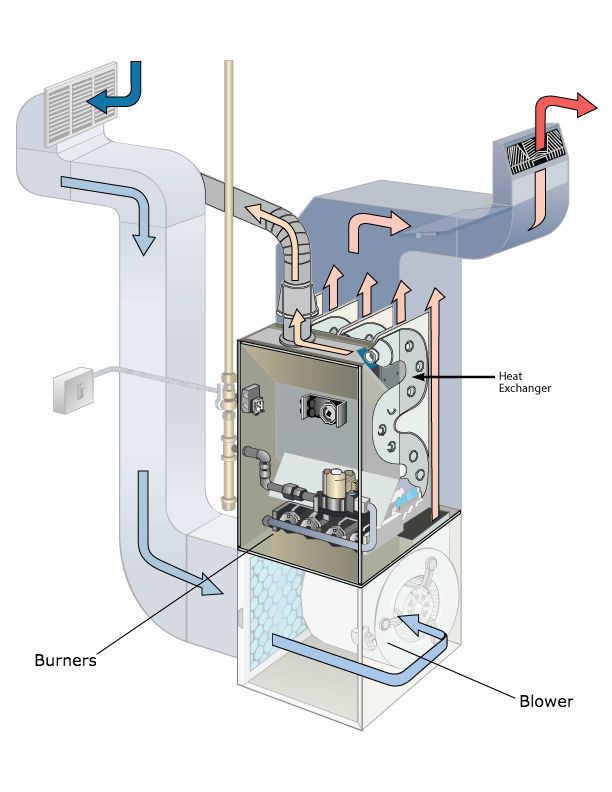In the market for a new furnace?
If so, you already know it’s an expensive investment, so you’ll want to pick a system that will serve you well and last for years to come.
Part of choosing the right furnace is deciding between a condensing and non-condensing furnace.
In Texas, specifically the San Marcos area, either type of furnace will serve your home well. The furnace you choose all comes down to cost:
- If you’re on a tight budget, we generally recommend you stick with standard non-condensing furnace.
- If you can afford a higher upfront cost, we often recommend investing in a condensing furnace, which is more efficient and can save you money in the long run.
Of course, these are just general recommendations. The only way to accurately recommend which furnace is best is to have a professional assess your home and your specific heating needs.
In this article, we’ll discuss:
- The difference between condensing and non-condensing furnaces
- Factors you’ll need to consider with a professional
Want to get furnace recommendations from a Texas HVAC pro? Visit our furnace installation service page to get familiar with our process OR
The difference between condensing and non-condensing furnaces
The main difference between these two types of furnaces is the number of heat exchangers they have. (A heat exchanger is the part inside a furnace that’s responsible for heating cold air.)

The heat exchanger, located in the heart of the furnace
A standard, non-condensing furnace only has one heat exchanger; a condensing furnace has two.
To explain why a condensing furnace has two heat exchangers, we first need to discuss how the normal combustion process works in a non-condensing furnace.
The normal combustion process
Inside the heat exchanger, fuel combusts to release heat. During this combustion process, some of the heat produced is lost, turning into water vapor and exhaust gases.
In a non-condensing furnace, these exhaust gases are carried out of the furnace via a flue pipe, which is essentially a chimney that funnels these gases into the outside air.
What does this mean? It means that standard, non-condensing furnaces waste a significant amount of fuel and potential heat when these exhaust gases leave the heat exchanger.
The benefits of a second heat exchanger
That’s where a condensing furnace comes in. A condensing furnace has a second heat exchanger that takes this water vapor and exhaust gas and squeezes more heat out of those fumes.
The result? Condensing furnaces are more energy-efficient, which means they cost you less to operate than a non-condensing furnace.
In fact, condensing furnaces can be 10%–20% more energy efficient than non-condensing furnaces. Over the lifetime of a typical furnace (15–20 years), an energy-efficient system can result in a lot of savings.
In addition to their improved energy efficiency, condensing furnaces also run longer at lower capacity which results in more even temperatures throughout the home (meaning less hot and cold spots).
Now that you know the difference between the two types of furnaces, let’s look at some of the factors you’ll need to consider to help you make your decision.
Factors you’ll need to consider with a professional
Even though condensing furnaces are more energy-efficient, they are also more expensive to install because they have a second heat exchanger and they require special venting.
So the question is—is a condensing furnace worth the higher upfront cost?
The answer depends on several factors specific to your home and heating preferences, which is why you’ll need to consult with a professional.
Below are some of the factors you’ll need to consider with a professional:
- The condition of your home’s ductwork: If your ductwork has leaks, then you’re losing a large part of your conditioned air. That means until you get the leaks sealed, you won’t see the energy savings of a condensing furnace.
- Your home’s insulation levels: Similar to leaky ductwork, if your home has poor insulation you won’t see the energy savings of a condensing furnace.
- The technology and features of the furnace you’re considering: Modulating burners and variable-speed blower motors are examples of advanced technology that improve the energy efficiency of your furnace. If you’re looking at a standard, non-condensing furnace that has those features, the energy savings could be comparable to the savings you’d get from a condensing furnace.
- How long you plan to stay in your home: If you don’t plan on staying in your home for a long time, then it may not be financially worth it to invest in a higher-priced condensing furnace.
Besides choosing between a condensing or non-condensing furnace, the HVAC professional you consult will also help you pick the correct size and efficiency rating (AFUE rating) for your furnace.
Ready to consult with a professional?
Our team of trained heating specialists have all the tools and knowledge to help you pick the right furnace for your home.
Learn more about the process of getting a new furnace by visiting our furnace installation page.

